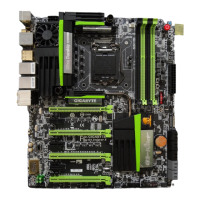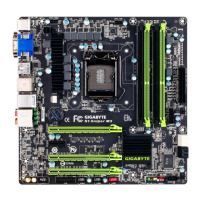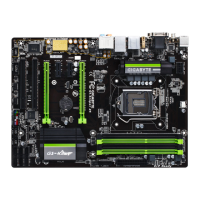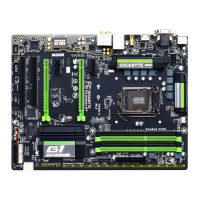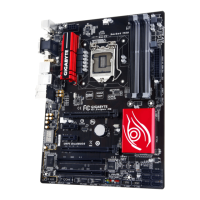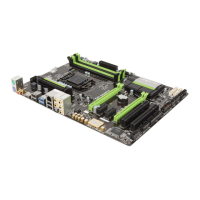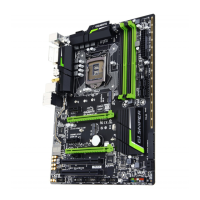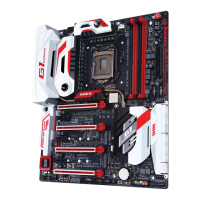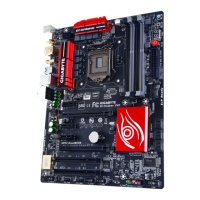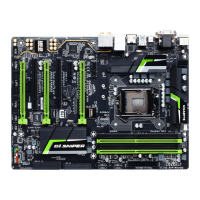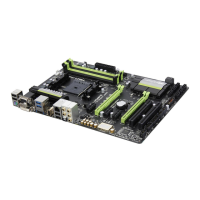Do you have a question about the Gigabyte G1.Sniper and is the answer not in the manual?
Guidelines for safely installing hardware to prevent damage.
Details on CPU, QPI, Chipset, Memory, Audio, LAN, Expansion Slots.
Step-by-step guide for installing CPU and its cooler.
Guidelines and configurations for installing DDR3 memory modules.
Steps for installing expansion cards into PCI Express or PCI slots.
System requirements and configuration for multi-graphics card setups.
Description of various connectors on the motherboard's back panel.
Explains onboard LEDs for voltage, overclock, and temperature.
Identifies and describes various internal connectors on the motherboard.
Displays screens that may appear when the computer boots (Logo/POST).
Overview of the BIOS Setup Main Menu and function keys.
Menu for configuring CPU/memory frequencies and voltages.
Settings for system date, time, and IDE/SATA device detection.
Settings for boot priority, CPU features, and display init.
Configuration for onboard devices like SATA, USB, Audio, and LAN.
Options for system power states and ACPI settings.
Monitors system voltages, temperatures, and fan speeds.
Loads the safest BIOS default settings for system stability.
Loads the optimal BIOS default settings for performance.
Sets passwords for BIOS access and system startup.
Saves BIOS changes and exits the setup program.
Exits BIOS Setup without saving any changes.
Instructions for installing chipset drivers using the driver disk.
Lists and allows installation of GIGABYTE utilities and free software.
Provides access to application guides and motherboard manuals.
Provides contact information for GIGABYTE headquarters and offices.
Displays basic system information like BIOS version and memory.
Links to GIGABYTE website for downloading latest BIOS, drivers, or apps.
Provides quick links to GIGABYTE's developed utilities for installation.
Utility for quick system backup and restoration. Supports NTFS, FAT32, FAT16.
Introduces GIGABYTE's BIOS update tools: Q-Flash and @BIOS.
Utility for fine-tuning system settings, overclocking in Windows.
Revolutionary technology for power savings and efficiency.
Easy tool for sharing data with computers on the same network.
Combination of 6 utilities for PC management, performance, security.
Utility to back up partitions as image files and restore them.
Feature to record passwords/dates and store data in main/backup BIOS.
Monitors and records system activities like power on/off times.
Manages computer usage time with simple rules and options.
Tool for system power savings via Bluetooth cell phone proximity.
Utility for configuring RAID-ready systems and expanding RAID capacity.
Overclocking utility for system tweaking via Internet-connected devices.
Steps to install, configure SATA controller mode, and set up RAID arrays.
Installing SATA drives and configuring Intel ICH10R SATA controllers.
Installing SATA drives and configuring JMicron JMB362 SATA controllers.
Installing SATA drives and configuring Marvell 88SE9182 SATA controllers.
Guide for installing SATA RAID/AHCI drivers and OS (Windows 7/Vista).
Instructions for installing SATA RAID/AHCI drivers during Windows XP setup.
Utility for viewing network status, bandwidth, and configuring settings.
Guides for configuring 2/4/5.1/7.1-channel audio and speaker setups.
Step-by-step guide to connect and configure multi-channel speakers.
Instructions for connecting and configuring S/PDIF Out for digital audio.
Details on Creative Audio Control Panel, Alchemy, and Sound Blaster X-Fi.
Guides for enabling Dolby Digital Live and DTS Connect encoding.
Steps for configuring audio recording using the Creative Console Launcher.
Frequently asked questions and answers for common issues.
A flowchart to diagnose and solve system startup problems.
Guidelines for safely installing hardware to prevent damage.
Details on CPU, QPI, Chipset, Memory, Audio, LAN, Expansion Slots.
Step-by-step guide for installing CPU and its cooler.
Guidelines and configurations for installing DDR3 memory modules.
Steps for installing expansion cards into PCI Express or PCI slots.
System requirements and configuration for multi-graphics card setups.
Description of various connectors on the motherboard's back panel.
Explains onboard LEDs for voltage, overclock, and temperature.
Identifies and describes various internal connectors on the motherboard.
Displays screens that may appear when the computer boots (Logo/POST).
Overview of the BIOS Setup Main Menu and function keys.
Menu for configuring CPU/memory frequencies and voltages.
Settings for system date, time, and IDE/SATA device detection.
Settings for boot priority, CPU features, and display init.
Configuration for onboard devices like SATA, USB, Audio, and LAN.
Options for system power states and ACPI settings.
Monitors system voltages, temperatures, and fan speeds.
Loads the safest BIOS default settings for system stability.
Loads the optimal BIOS default settings for performance.
Sets passwords for BIOS access and system startup.
Saves BIOS changes and exits the setup program.
Exits BIOS Setup without saving any changes.
Instructions for installing chipset drivers using the driver disk.
Lists and allows installation of GIGABYTE utilities and free software.
Provides access to application guides and motherboard manuals.
Provides contact information for GIGABYTE headquarters and offices.
Displays basic system information like BIOS version and memory.
Links to GIGABYTE website for downloading latest BIOS, drivers, or apps.
Provides quick links to GIGABYTE's developed utilities for installation.
Utility for quick system backup and restoration. Supports NTFS, FAT32, FAT16.
Introduces GIGABYTE's BIOS update tools: Q-Flash and @BIOS.
Utility for fine-tuning system settings, overclocking in Windows.
Revolutionary technology for power savings and efficiency.
Easy tool for sharing data with computers on the same network.
Combination of 6 utilities for PC management, performance, security.
Utility to back up partitions as image files and restore them.
Feature to record passwords/dates and store data in main/backup BIOS.
Monitors and records system activities like power on/off times.
Manages computer usage time with simple rules and options.
Tool for system power savings via Bluetooth cell phone proximity.
Utility for configuring RAID-ready systems and expanding RAID capacity.
Overclocking utility for system tweaking via Internet-connected devices.
Steps to install, configure SATA controller mode, and set up RAID arrays.
Installing SATA drives and configuring Intel ICH10R SATA controllers.
Installing SATA drives and configuring JMicron JMB362 SATA controllers.
Installing SATA drives and configuring Marvell 88SE9182 SATA controllers.
Guide for installing SATA RAID/AHCI drivers and OS (Windows 7/Vista).
Instructions for installing SATA RAID/AHCI drivers during Windows XP setup.
Utility for viewing network status, bandwidth, and configuring settings.
Guides for configuring 2/4/5.1/7.1-channel audio and speaker setups.
Step-by-step guide to connect and configure multi-channel speakers.
Instructions for connecting and configuring S/PDIF Out for digital audio.
Details on Creative Audio Control Panel, Alchemy, and Sound Blaster X-Fi.
Guides for enabling Dolby Digital Live and DTS Connect encoding.
Steps for configuring audio recording using the Creative Console Launcher.
Frequently asked questions and answers for common issues.
A flowchart to diagnose and solve system startup problems.
| Non-ECC | Yes |
|---|---|
| Memory voltage | 1.5 V |
| Memory channels | Triple-channel |
| Number of memory slots | 6 |
| Maximum internal memory | 24 GB |
| Supported memory clock speeds | 800, 1066, 1333, 2200 MHz |
| System bus rate | 6.4 GT/s |
| Processor socket | Socket B (LGA 1366) |
| Processor manufacturer | Intel |
| Compatible processor series | Intel® Core™ i7 |
| USB 2.0 connectors | 3 |
| Number of SATA III connectors | 2 |
| Number of EATX power connectors | 1 |
| Number of Parallel ATA connectors | 0 |
| USB 2.0 ports quantity | USB 2.0 ports have a data transmission speed of 480 Mbps, and are backwards compatible with USB 1.1 ports. You can connect all kinds of peripheral devices to them. |
| Audio chip | Creative CA20K2 |
| Component for | PC |
| Audio output channels | 7.1 channels |
| Motherboard form factor | ATX |
| Compatible operating systems | Microsoft Windows 7/Vista/XP |
| On-board graphics card | No |
| Parallel processing technology support | 3-Way SLI |
| PCI Express slots version | 2.0 |
| Controller interface type | SATA 6Gb/s |
| Controller 2nd interface type | SATA 3Gb/s |
| RAID levels | 0, 1, 5, 10 |
| LAN controller | Bigfoot Killer E2100 |
| Ethernet interface type | Gigabit Ethernet |
| BIOS type | AWARD |
| ACPI version | 1.0b |
| BIOS memory size | 32 Mbit |
| Depth | 264 mm |
|---|---|
| Width | 305 mm |

